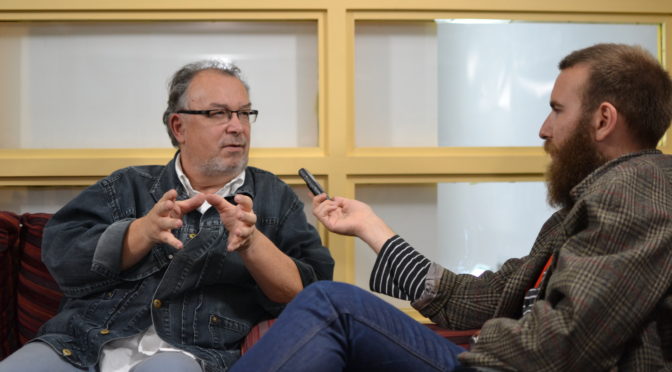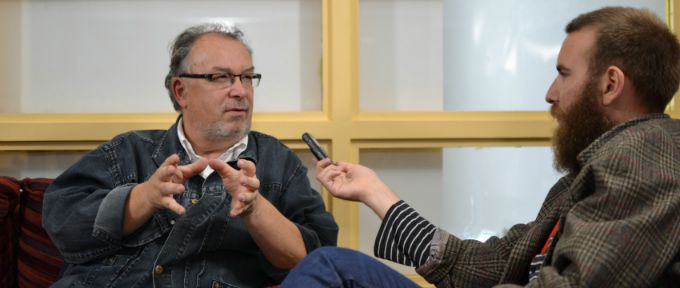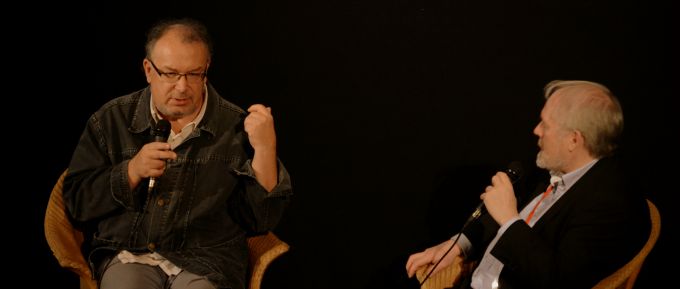Having first appeared at the Cambridge Film Festival in 1981 with his debut feature The Knight, Lech Majewski returns this year for a retrospective of his career. The first three films of Majewski’s to screen this week – THE GARDEN OF EARTHLY DELIGHTS, THE MILL AND THE CROSS, and ONIRICA – comprise a trilogy that draws inspiration from the work of the artists Bosch, Breugel and Dante. We caught up with the visionary director to further explore the relationship between painting, artifice and the moving image in his work.
For people who aren’t familiar with your work, could you please introduce the trilogy that has just screened at this year’s festival?
I don’t call it a trilogy, I call it a triptych. My main inspiration comes from paintings and from visuals, therefore triptych is the correct term as all three films in the trilogy take their cues from artworks. The first film, THE GARDEN OF EARTHLY DELIGHTS, tells the story of an art historian working at the National Gallery in London who travels to Venice to work on the painting “Hieronymus” by Bosch. While she’s there she gets entangled in a relationship with a man, and they discover the painting together. Similarly, THE MILL AND THE CROSS is inspired by Pieter Bruegel’s painting “The Way to Calvary”. I was particularly inspired by a text by Michael Gibson who analyses the painting, which gave me the idea to make this into a feature. The last film in the trilogy, ONIRICA, is inspired by Dante. Dante is of course a poet, but for me his writing is so visual and more like a painting. The visions and symbols in his work are so dense that you cannot rush into it. You just have to be patient and take it all in. When you enter into it, you enter into a tremendously strong visual thicket that literally tears at your skin.
The idea of this “visual thicket” feels central to all of your films. I got the feeling that you enjoy the task of entering an artwork or a space that appears to be still from the outside, and then moving around in this space. Once you’re in the space, you seem to expand time so that you experience the visuals in a way very different to traditional narrative cinema in which the spectator moves from one plot event to the next. In ONIRICA, for example, there is a scene in which the camera moves around a dark forest full of unmoving objects and people.
This is interesting. In a way it’s like blowing up time or blowing up the vision that’s inside something so you can explore it more fully. The film ONIRICA uses in particular the idea of the “Clearing”, or Lichtung, from Heidegger’s philosophy, which is present in the image of the forest and the still people. The idea of the “clearing” is beautiful. Heidegger using this metaphor of the clearing to capture various mysterious, metaphysical aspects of our lives. The problem is this: a hundred years ago, you and I did not exist. Where were we? Were we circulating as chemicals or atoms, or electric flows passing somewhere? For Heidegger, we were not chemical, physical or electrical substances flowing in our ancestors’ bloodstreams – indeed, as the human body is fully replaced every seven years, we are never even the same atoms – so we were not even flowing in our ancestors. In Heidegger’s vision, this “before” is represented by the dark forest. When our time comes, we enter the clearing, and the light presents us to others. As the light only comes from one direction, they are only perceived by half, never in our entirely. This image of the clearing is so poetic, and as far as our “being” is concerned it really gets to the heart of the idea. Philosophers tend to be either poets or theoreticians. If you read Kierkegaard, Nietzsche or Heidegger, for example, you realise that you are reading poetry.
“I am always annoyed that usually in the cinema there is a bunch of people hanging above the lovers, powdering them and giving them their lines and providing them with donuts…”
The use of static bodies and images filmed by moving cameras recurs throughout the trilogy, and you seem fascinated by images of slowness and even stasis. Is this connected to the idea of the clearing, and being able to look at things more clearly in the light whilst also experiencing an inaccessibility towards them? Whilst your film THE MILL AND THE CROSS enters the painting, there are parts that remain two-dimensional and distanced…
I don’t agree with the idea that I slow things down, as this is a relative aspect. I’m always asking why people go to a classical music concert, spend an hour and a half looking at practically nothing and then applaud, and yet when they go to an art gallery they are perfectly content to spend no more than five minutes looking at a particular painting. By comparison, a lot of people come to me and ask me how they can see my films a second time. They want to come back to these films so that they can take more in. They want to see more of it. For these people it wasn’t slow, it wasn’t enough.
I’m thinking of slowness not in terms of narrative slowness, but in terms of physical slowness and stasis…
But you see, even when people are standing still, the camera moves around then. Things are still moving. For me this creates a more profound camera that can look deeper into the layers of the image. A camera that records lots of movement and fast happenings is, for me, a very shallow camera.
The question of the camera is particularly interesting in THE GARDEN OF EARTHLY DELIGHTS. The film is filmed by the actors themselves on a home video-camera, so you lose the feeling that there is any director or crew behind the camera at all and you’re completely alone with the characters in that space…
I like to experiment. In terms of THE GARDEN OF EARTHLY DELIGHTS, I was dealing with a love story, and a tragic love story at that. I am always annoyed that usually in the cinema there is a bunch of people hanging above the lovers, powdering them and giving them their lines and providing them with donuts, etc. I thought it would be interesting to leave them alone. I brought the metaphor to the situation that every love affair is like a flight. When you’re in love you levitate, you become gaga, you fly above the ground. And for me, the self-recording camera was like a black box of that flight, like you find in an aviation disaster. So when this love affair crashes, the recording on the camera is a bit like the black box of love’s flight, having recorded everything that happened in between and what went wrong. In the film, the female protagonist is obsessed with the longevity of the image. She keeps asking the question of how a camera made up of simple chemicals and mechanisms will survive her, how a two dimensional image seems far more robust than a living body. You have to realise that if the flight is not doomed, if the love is not doomed, you will never know what was in the black box.
Another two of Majewski’s films – THE ROE’S ROOM and WOJACZEK – will screen on the 10th September at 3pm and 8pm respectively.
httpvh://www.youtube.com/watch?v=nfw32a6E7BI




One thought on “Interview with Lech Majewski”
Comments are closed.